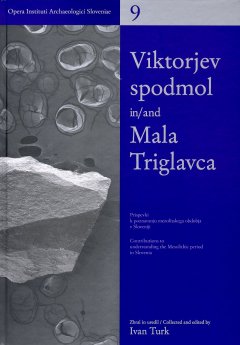 Institute of Archaeology Institute of Archaeology |
[Slovenian] |
| Home | Members | Programme | Projects | Laboratory |
| Database | Publications | Library | Links | Archive |
The monograph, the first regarding the Mesolithic in Slovenia, presents a discussion of two exceptionally rich sites in the Karst in western Slovenia: Viktorjev spodmol and Mala Triglavca. Viktorjev spodmol is a newly discovered site, where test excavation have only been done, while research is underway at Mala Triglavca already a while. The compilation primarily presents a detailed review of Viktorjev spodmol. The comparison of results from various field and post-field methods, which were applied at both Mala Triglavca and especially at Viktorijev spodmol, is particularly important. Individual chapters address the topic of microlithic tools attributed to the Sauveterrien-Castelovien complex, their typology and relations with other sites from this complex, and with a special emphasis on the chronology and chronological correlations between Mesolithic sites in northern Italy, including the Trieste karst, and western Slovenia (I. Turk in M. Turk). The remaining chapters systematically present rare vegetal remains (M. Culiberg), the exceptionally rich collections of mollusc's fauna (R. Slapnik, V. Mikuž), ectothermic vertebrates (M. Paunović) and small mammals (B. Toškan, B. Kryštufek) as well as the remains of large mammals (B. Toškan). At Viktorijev spodmol about 58,000 remains of slowworm and 6,076 remains attributed to 103 other animal species were discovered upon a surface of two square meters in the Mesolithic layer. The same surface revealed 72 typologically classifiable microliths, 104 macrolithic tools and 12,708 debris. Mala Triglavca is equally profuse, although it is discussed only summarily in this monograph, and with an emphasis on Mesolithic artefacts. From among these finds, the numerous trapezes are particularly noteworthy, and from among the more rare finds at least the bone whistle and flute. The Holocene fauna from both sites comprises a few rare and as such, interesting species: the black rat, grey hamster, Martino's vole, beaver, dog and elk. Also noteworthy are the rare human remains discovered at both sites, which are discussed in brief in their own chapter (I. Štamfelj, I. Turk) and in more detail in the annex (I. Štamfelj with colleagues). The second annex (I. Turk) presents the 14C dates for both sites, as well as the issue concerning chronometry as a method for classifying and correlating Mesolithic sites. The monograph concludes with 20 plates, which display the discovered Mesolithic artifacts in their natural size as well as enlarged. The compilation concludes with 20 plates, which display the discovered Mesolithic materials in their natural size as well as enlarged. The book is printed in two languages with the Slovenian and English texts flowing in parallel columns. 2004, (Opera Instituti Archaeologici Sloveniae, 9), 247 pp + 20 tables, 64 b/w photos, drawings and charts, 20 x 29 cm, hardcover, IISBN 961-6500-54-6. |
